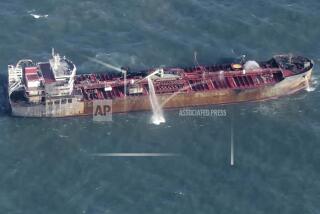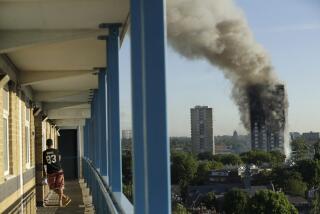Oil Well Disaster Sparks Calls for Better Safety, Design Changes
- Share via
ABERDEEN, Scotland — The explosion and fire that destroyed a North Sea oil platform and claimed 166 lives brought calls Friday for improved safety standards and major revisions to the design of structures operating in the hazardous environment.
At a news conference here, Occidental Petroleum Chairman Armand Hammer agreed that crew living quarters would probably have to be separated from the production area in future platforms.
“It may be that living quarters will have to be removed from the precarious position they are (in) now,” he said.
Occidental owns the 12-year-old destroyed rig, among the oldest of the North Sea’s 38 manned platforms. On Friday, a small fire still smoldered around the blackened structure, 120 miles northeast of here.
It was the world’s worst oil field disaster, and some believe it could also become the world’s most expensive single insurance claim.
$500-Million Insurance
The platform is believed to have been insured through the Lloyd’s of London marine market for more than $500 million.
With other, nearby platforms also shut down as a precautionary measure, production of about 340,000 barrels per day--roughly 15% of Britain’s North Sea production--has been suspended.
Late Friday, crude oil leaked from five wellheads, and while Britain’s Department of Trade and Industry insisted there was no pollution threat, the Norwegian government declared an emergency alert.
Hammer said the initial explosion was caused by a gas leak in a module that separates gas from the crude oil.
The crew quarters on the platform were situated directly over the gas separation module.
“In talking with survivors, we found out that when the first explosion came, there was complete darkness,” Hammer added. “Men were groping to find the exits. Everything failed. We had backup lights and pumps, but the explosion was too great.”
A recently completed platform for the Norwegian sector of the North Sea has already placed the crew living quarters on the opposite side from the production area, with three insulation walls between them.
As Hammer spoke, oil well trouble-shooter Paul (Red) Adair surveyed the platform from a helicopter to determine how to salvage the wreckage and the 36 wells that the platform served.
In 1977, Adair helped extinguish a major North Sea oil fire following a blowout in the Norwegian sector’s Ekofisk fields.
Occidental spokeswoman Kate Graham said only 64 of the 228 men aboard the giant steel platform survived Wednesday’s explosion and fire, while two rescue boat crew members also perished in the flames.
17 Bodies Recovered
Seventeen bodies have been recovered so far from the frigid North Sea, but it is now believed many of those who died were trapped in the platform’s crew quarters, which simply disappeared after the explosion.
Graham said that “a few small fires” continued to burn Friday, both on the platform and in the wellhead area. Many of those who survived the disaster were hospitalized with severe burns.
After visiting injured survivors, British Prime Minister Margaret Thatcher announced that Britain’s Department of Energy will conduct its own technical investigation in addition to the full-scale public inquiry announced Thursday by the government.
As British trade union leaders called for tighter safety regulations in the wake of the disaster, 150 British Petroleum North Sea gas platform maintenance workers resigned from their jobs Friday, claiming that their working conditions were unsafe.
A disaster fund for families of the dead immediately reached $5 million, with Occidental Petroleum and the British government donating $1.7 million each.
More to Read
Sign up for Essential California
The most important California stories and recommendations in your inbox every morning.
You may occasionally receive promotional content from the Los Angeles Times.








